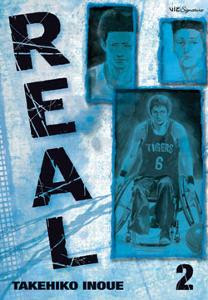
In recognition of Takehiko Inoue's birthday today, I'm posting a review of the second volume of his basketball series, Real. Thanks to David Welsh of Manga Curmudgeon for the head's up!
The story: Nomiya and Togawa are two young men dealing with disability and a shared inability to play basketball as much as they'd like. After being beaten by an elite wheelchair player, Togawa is focused on rejoining his team, the Tigers. Unfortunately, his burned bridges may make that a tougher order than he expected. Sandwiched at volume's middle is the continuing saga of Nomiya's ex-teammate, Hisanobu, who was hit by a garbage truck and sustained a spinal injury, and whose road to rehabilitation is paved with denial. At volume's end, Togawa's past is revealed, including his life before his disability occurred.
Reaction: There are some purely painful moments to watch -- from Hisanobu's slow acceptance of his permanent paralysis to Togawa's rise and fall in sprinting, Takehiko Inoue has a true talent for relating heartbreaking scenes filled with palpable emotion. And then there is the intensity inherent in every panel -- I watched as someone hit rock bottom, while another felt himself rise to the top. But, this isn't drama for drama's sake, either; it serves a greater purpose in Inoue's hands. It's an illustration of the ways in which we're forced to live in the face of tragedy.
Deep thoughts: Togawa's leg amputation is due to osteosarcoma, a type of bone cancer. It most often occurs in the knees or upper arms, and most often strikes people between ages 10 and 19. Considering Togawa was in middle school when he was disagnosed, it was a prime time for him to develop this rare cancer. While amputation is an extreme form of tumor removal, it is quite effective.
Artwork: This volume, like the last, opens with color portraits of Nomiya and Togawa, and additional color pages are sprinkled between chapters. Inoue has an uncanny ability to capture subtle nuances of emotion, a simple quirk of the brow or squinting eye, can convey so much. This is especially important when there's no way to incorporate body language as the cast has varying levels of mobility. Perhaps showing his experience with action-oriented stories, Inoue's panel pacing and composition keep the reader steady while setting the appropriate tone.
The verdict: Required reading. Honestly, this is a poignant, amazing, yet humble, portrayal of the human spirit. With Inoue's vast skill apparent, this series moves as deftly from humor to tears as a ball smoothly dribbled across the court. These are troubled young men, with basketball their only hope of redemption. At times both startling and inspiring, I can't recommend this manga enough. Real is available in the U.S. from Viz.
No comments:
Post a Comment